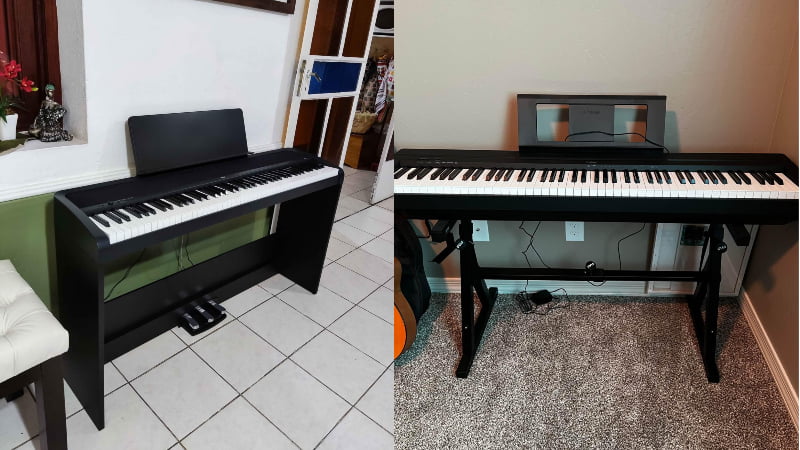Yamaha and Korg are some of the biggest names in the digital piano market today. And in this Yamaha P71 vs Korg B2 comparison, I put two of their best beginner pianos up against each other.
When testing out these pianos, I found it incredibly hard to choose a winner. Both coming from reputable brands, both the P71 and B2 came with great features ideal for beginners learning the instrument. However, because of a wider voice library and sound system, the Korg B2 narrowly came out on top.
The Yamaha P71 put up a very good fight though, with very bright tones, great feel and playability, and a wide variety of playing modes, it’s still one of the best entry-level options out there. The P71 was just lacking in the variety of tones and the sound system isn’t the best, which is why it couldn’t edge out the Korg B2.
Yamaha P71 vs Korg B2: Comparison Chart




Last update on 2025-07-11 / Affiliate links / Images from Amazon Product Advertising API
Yamaha P71 vs Korg B2: Differences
I figured the best way to find a winner between these two is to compare their features. Since both are beginner digital pianos, they come with a wide set of features that can help the learning process. And by the end of the comparison, I found that the Korg B2 was the winner by a slim 3-2 victory because of its tone and sound system.
Feel & Playability
The winner: Tie
In terms of feel, I put both of these pianos on the same level. For a digital piano for beginners, it offers great hammer action and weight. Both of these instruments feel similar to acoustic pianos, though when testing them out, I did find some areas that need improvement, which is normal for pianos in this price range.
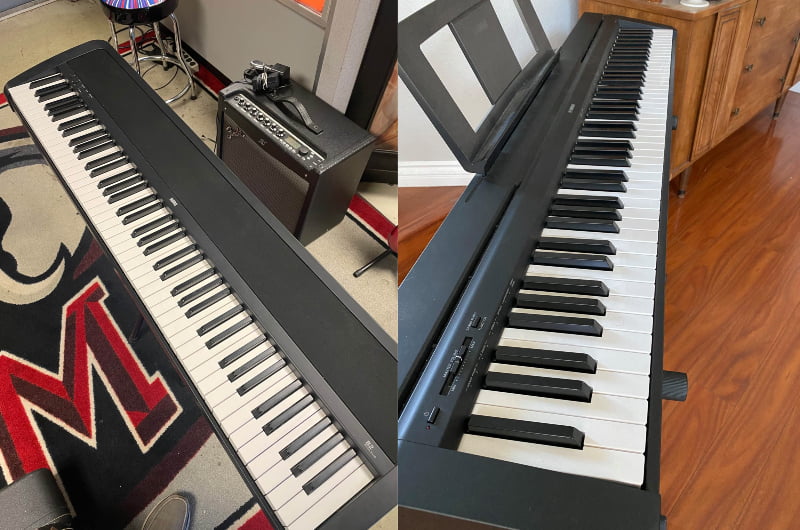
Hammer Action
Both of these keyboards have a form of progressive hammer action. To mimic the feel of an acoustic piano, the brands made the keys on the left side slightly heavier than the ones on the right side. So, as you go up the notes of the keyboard, the hammer action becomes slightly lighter.
In their price range, I couldn’t find pianos with better hammer action. Both have a pretty hefty weight to it, which makes the keys really feel like an acoustic piano. Admittedly, the Korg B2 has slightly heavier hammer action, but not by a lot.
Key Texture
In terms of key texture, both of these pianos are lacking. Both the Yamaha P71 and Korg B2 have plastic keys without any coating on top. That means that when you play these pianos, it will feel like pressing down on plastic. While the B2 has a matte finish on the black keys, it still isn’t enough to feel like real wooden keys on an acoustic piano.
While it was disappointing that the keys had a plastic feel, that’s very normal in this price range. If either Korg or Yamaha added textured or wooden keys to these pianos, that would have jacked up the price significantly, making them out of reach for a lot of beginners.
Touch Sensitivity
Another feature I enjoyed on both these pianos is the touch sensitivity variations. Both of the pianos have hard, medium, and soft sensitivities. That means that when you play either of these pianos, pressing harder will result in a louder and more aggressive tone than pressing softer.
The only difference between these two pianos is that the Yamaha P71 has fixed sensitivity. If you’re looking to play expressively, you probably won’t use this feature, however, for practicing and getting the notes right, it does come in handy.
Tone
The winner: Korg B2
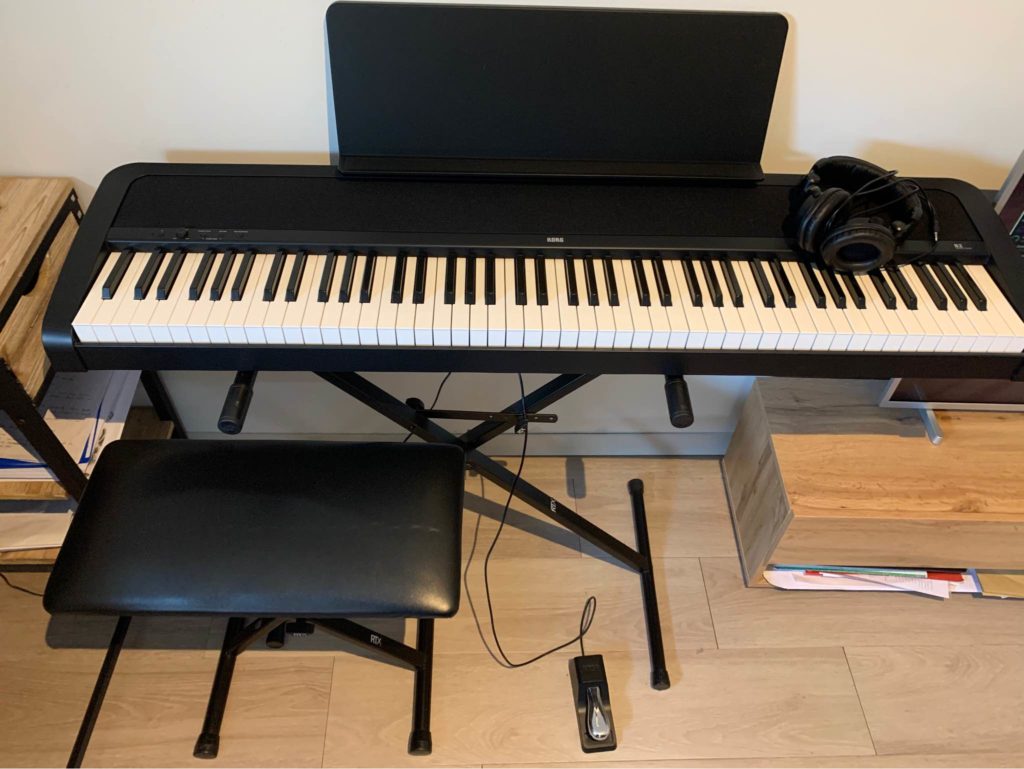
Comparing the tones of these two pianos was very hard since tone is a very subjective topic for musicians. However, in the end, the Korg B2 was the winner. While I personally preferred the tones on the Korg B2, I wouldn’t say they were that much better than the P71, they were just different. The main reason the Korg B2 was the narrow winner in this regard was because of the wider sound library.
Tone Generation
The Korg B2 uses PCM Stereo Sampling. This is a common method used by most entry-level Korg pianos, and it makes for a very nice sound. This technology works by playing multiple samples every time you press a key on the piano. The result is a more realistic and well-rounded tone that sounds very similar to the instrument it’s trying to mimic.
When listening to the tones, I found that the Korg B2 had very warm piano sounds. This is great for students and makes for a very mellow sound. This is a great contrast to the Yamaha P71, which is known for its bright and crisp tones. I personally preferred the sound of the Korg B2, but there are definitely pianists out there who would prefer the tone on the Yamaha P71.
The Yamaha P71 uses the AWM Sampling Method. This works by sampling real Yamaha pianos with natural decay and putting a digital filter to make it sound more realistic. The result is a very distinct tone that’s reminiscent of most Yamaha pianos.
Sound Library
The main reason the Korg B2 got the point over the Yamaha P71 when it came to tone is the sound library. Granted, both of these pianos have relatively small sound libraries, but they are more than enough for a beginner to familiarize themselves with the instrument.
The Korg B2 hosts 12 different voices while the Yamaha P71 has 10. This isn’t a large difference, but it gives the B2 a slight edge. With the Korg B2, pianists have access to a wider range of voices, which is what makes it the more versatile option. However, if you’re starting out as a pianist, the Yamaha P71 is more than what you’ll need.
Piano Features
The winner: Yamaha P71
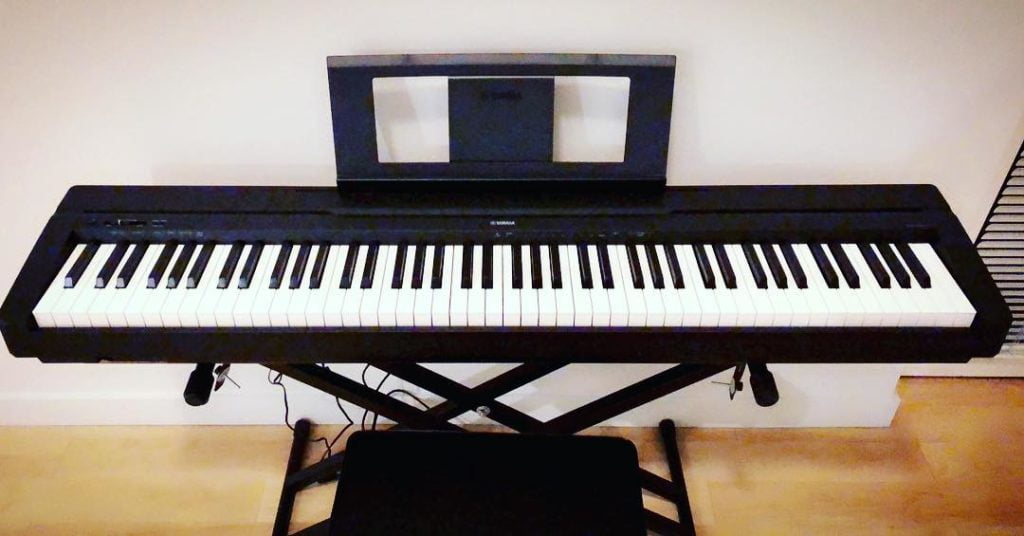
This area was another very close battle, but in the end, the Yamaha P71 was the one that came up on top. With better polyphony and a wider variety of playing modes, it was easy to see why the Yamaha P71 remains the favorite beginner’s piano for many pianists out there.
Polyphony
At first glance, it might seem like the Korg B2 has better maximum polyphony as it’s listed that the instrument has 120-note maximum polyphony. Don’t be deceived as that only goes for specific voices and most of the other sounds only have 64-note maximum polyphony.
On top of that, since the Korg B2 plays multiple samples whenever you press a key, it evens out to somewhere between 14-16 note maximum polyphony. This is very small, but it’s a sacrifice you have to make for the great piano tones on this instrument. The polyphony is enough to handle wide chords even with the sustain pedal, but you might run into some trouble playing the more complicated pieces.
The Yamaha P71 has a true 64-note maximum polyphony. That means it can handle wider chords much better than the Korg B2, which is something a lot of people notice when testing out these instruments.
Playing Modes
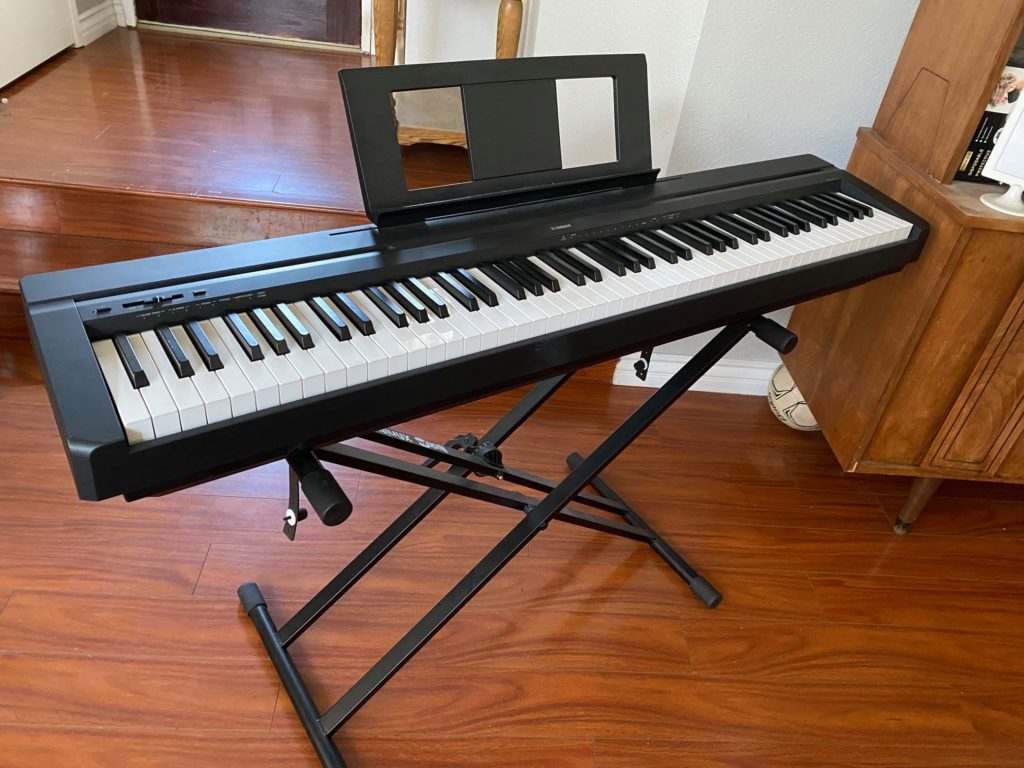
In terms of the different playing modes, the Yamaha P71 is also the winner. The Korg B2 comes with Duo mode and nothing else. With that said, duo mode is still a very useful feature, especially for beginners.
With duo mode, you can divide the piano into two smaller mini pianos with the same tuning. That way, the right side of the piano will sound exactly the same as the left side. This is a great feature for piano lessons as teachers can demonstrate different techniques and passages without needing to cross-over to the other side.
The Yamaha P71 also has a duo mode feature. However, on top of that, it comes with a dual playing mode. With this mode, every time you press down on a note, you will play two different voices. For example, you can combine the string and piano voices for richer accompaniment. Or you can even combine the piano and bass tones for a unique sound.
Because of this extra playing mode, the Yamaha P71 has more versatile piano features, which is what puts it on top in this category.
Connectivity
This is the one area where the Korg B2 wins in terms of piano features. The Yamaha P71 doesn’t offer that many connectivity options and can’t connect to Yamaha apps like other models in the “P” range. The Korg B2, on the other hand, offers MIDI connectivity via a type 2 USB.
This allows you to use the piano as a MIDI controller for virtual instruments or piano learning apps on your phone or computer!
Sound System
The winner: Korg B2
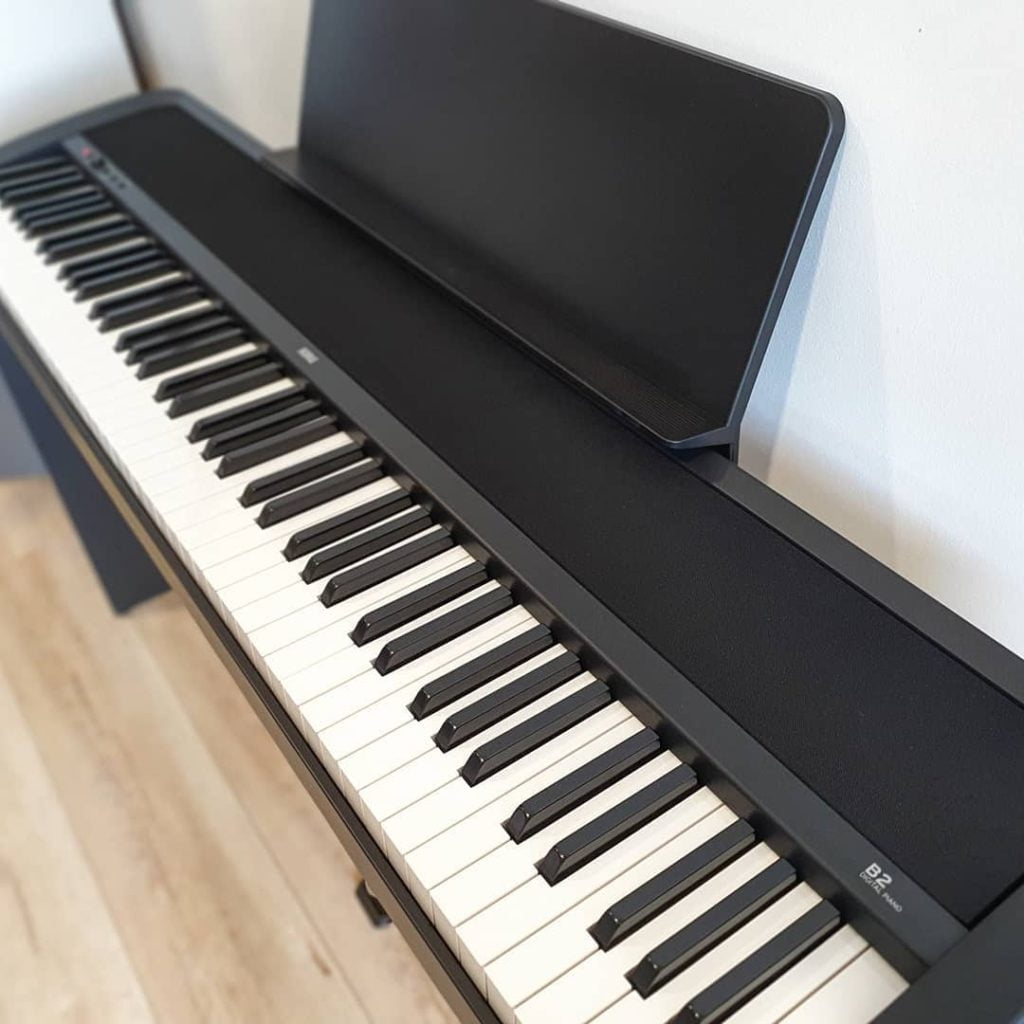
The tie-breaker between these two pianos was the sound system. And after taking a close look, the Korg B2 is the winner. The speakers on the B2 aren’t exactly professional-level, but they are fairly loud. With two 9W speakers, you get some pretty loud and rich tones that make it easier for you to hear yourself when rehearsing or jamming.
On top of that, it has an output at the back where you can plug in headphones or external speakers. You can also plug in your phone or music device to play a backing track through the speakers to jam along to! However, it only has a single output at the back, which is slightly disappointing.
With the Yamaha P71, you only get two 7W speakers. Now, for their size, these are some pretty loud and high-quality speakers. However, it can’t beat out the speakers on the Korg B2. Like its Korg counterpart, the Yamaha P71 also has outputs at the back that you can use to connect external audio devices if you need to practice privately or make the sound louder.
Yamaha P71 vs Korg B2: The Similarities
Both pianos shared some similarities at the end of the day. The reason for this is that they’re both designed for beginners and do a great job at it. For starters, you have fully-weighted 88-key keyboards on both pianos, which gives you a very realistic feel which is very important when learning the instrument. Additionally, they both come with all the tones you’ll need to start learning to play and experiment with the piano.
Another similarity is that these are both lightweight and portable pianos. You can easily bring either the Yamaha P71 or Korg B2 with you to gigs, jams, or even piano lessons. You can find bags designed for these pianos, which allows you to easily carry it around with you during your musical journey.
Quick Rundown of the Korg B2
Last update on 2025-07-11 / Affiliate links / Images from Amazon Product Advertising API
Quick Rundown of the Yamaha P71
- Acoustic Piano Feel - Touch-sensitive keys allow for true expression and dynamic performance. The weighted action replicates the acoustic piano experience
- Elevated Sound - Choose from 10 unique Voices, including the richness and resonance of a Yamaha grand piano, with full dynamic sound and deep bass
- Effortless Control - Simple one-button operation and streamlined functionality designed to keep you focused on your music
- Layered Sound - Dual Mode lets you blend two Voices, like piano and strings, creating a rich, layered sound for an inspiring new playing experience
- Included sustain pedal allows for subtle variations and greater expression in your performances
Last update on 2025-07-11 / Affiliate links / Images from Amazon Product Advertising API
Product Video
Related Articles to Korg B2
- Alesis Prestige Artist vs Korg B2: The Better $500 Digital Piano
- Yamaha P45 Vs Korg B2: Which Digital Piano Fits Beginners Better?
- Alesis Recital Pro vs Korg B2 Comparison: Which Digital Piano Should You Get?
Related Articles to Yamaha P71
- Alesis Virtue Vs Yamaha P71: Can The Alesis Console Piano Beat Out The Amazon Exclusive?
- Yamaha P71 vs P95: Which Is The Better Digital Piano?
- Yamaha P71 vs Casio CDP-S150: Which Is the Best Beginner Piano On the Market?
- Yamaha P71 vs DGX-660: Can the Amazon Exclusive Beat Out the Premium Model?
- Yamaha P71 vs Donner DEP-20: Which Is the Best Beginner Piano?
- Yamaha P71 vs Casio PX-160 Comparison: Battle of the Two Best Digital Pianos on a Budget
- Yamaha P71 vs Alesis Recital: Why the Amazon Exclusive P71 Is the Best Option for Beginners
- Yamaha P71 vs Roland FP10 Review: A Tight-Knit Battle Where The FP10 Comes Out On Top
- Yamaha P71 vs Alesis Recital Pro: Which Digital Piano is the Best Option for Beginners?
- Yamaha P71 vs P125: Why the Yamaha P125 Is the Better Investment
- Yamaha P71 vs P45: Why the Amazon Exclusive P71 is the Better Digital Piano
References:
- B2 digital piano: https://www.korg.com/ph/products/digitalpianos/b2/specifications.php
Lulacruza is an electronic folk duo operating at the junction of the hypermodern and the ancient. Our music weaves together hypnotic female singing, South American folk instruments and electronic processing, while channeling pulsating waves from the source of creation.
Lalucruza is also a community where you can connect with other music lovers to collaborate, exchange ideas and share knowledge. A platform for who wants to learns the basics of playing piano, guitar, drum masters’ technique, etc.. is the premise of our website.
